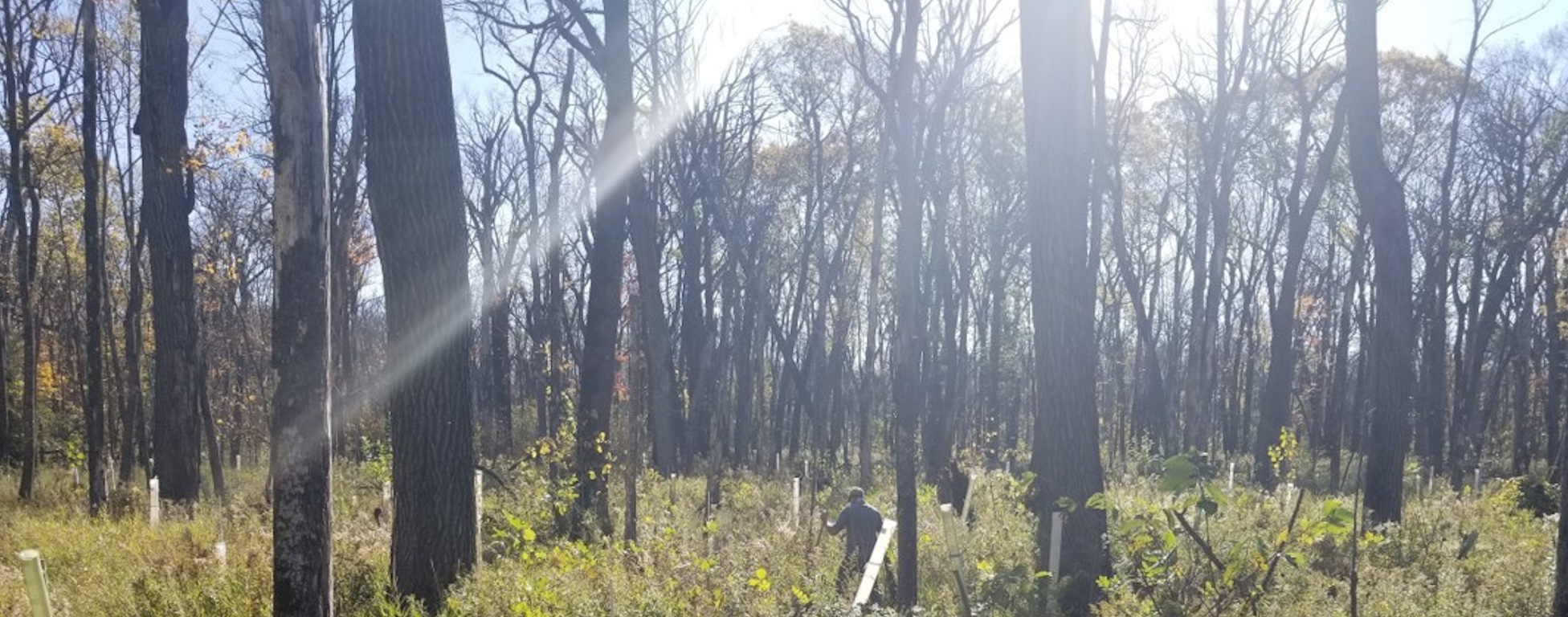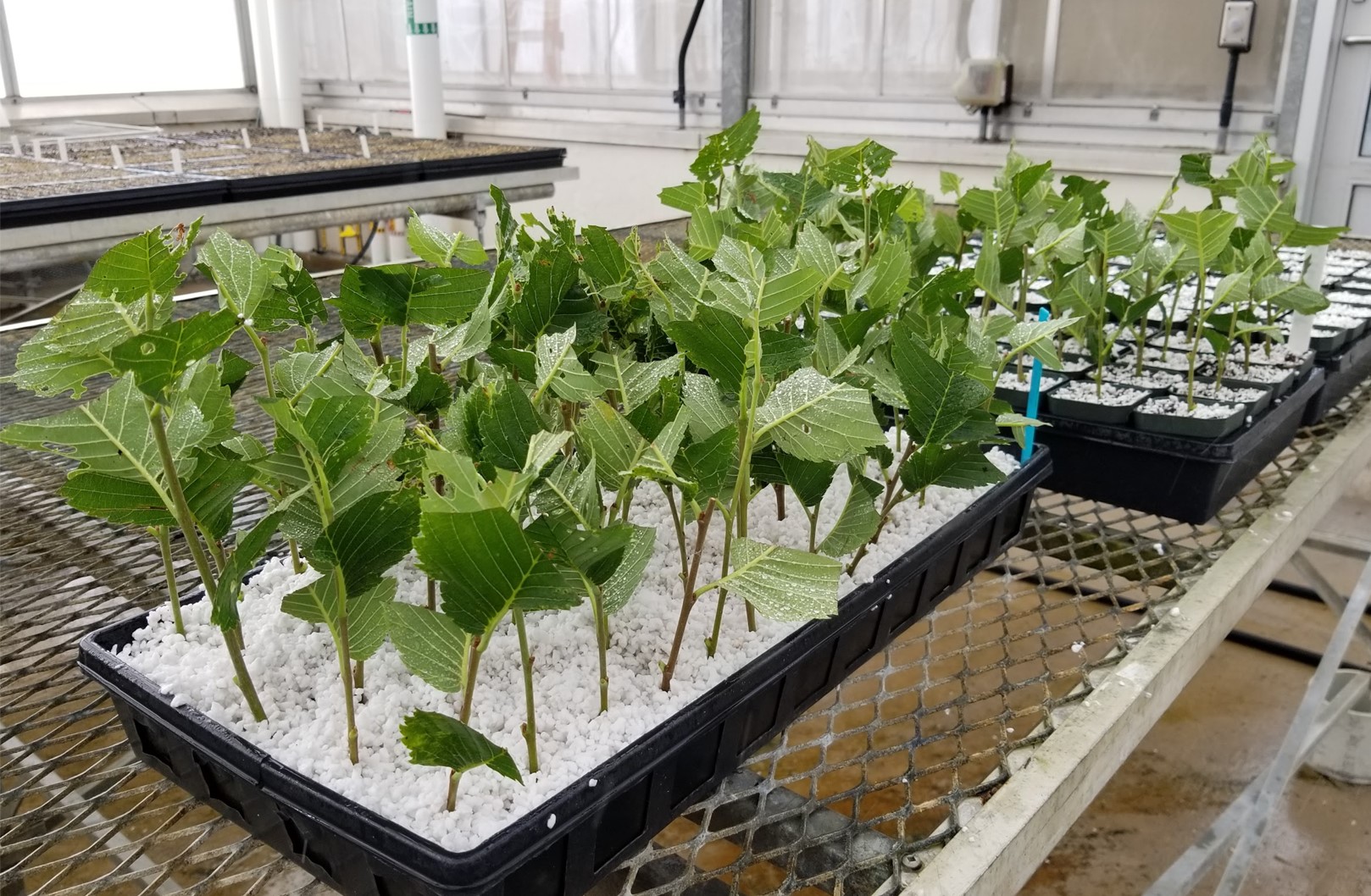MITPPC-funded researchers are strategically wrangling the charismatic trees’ innate ability to fend off Dutch elm disease.
by Carolyn Bernhardt

The durable, stoic elm tree has become an emblem of American landscapes. And for good reason. “Elms have huge inputs to any ecosystem,” says Benjamin Held, a researcher in the Department of Plant Pathology at the College of Food, Agricultural and Natural Resources Sciences (CFANS). These charismatic trees intercept thousands of gallons of runoff each year and offer food and habitat to insects and other animals.
According to urban forestry expert Ryan Murphy, a researcher in CFANS’s Department of Forest Resources, elms in urban settings also help reduce winter heating and summer cooling costs. “Their large canopies reduce wind speeds around a building,” he says. This keeps the warm air in during the winter months. In summer months, canopy shade helps reduce cooling needs.
“Elms adapt to a lot of environments because they are very resilient,” Held says. “They can withstand drought, salt, compaction, and floodplains better than most species.” Unfortunately, what these magnificent pillars to Minnesota ecosystems cannot withstand is an invasive pathogen carried on bark beetles, which carve galleries into elm trees just below the bark. The fungus these insects ferry directly to the tree’s vascular system—Ophiostoma novo-ulmi—is notorious for causing the widely-dreaded Dutch elm disease (DED).
While a large elm population across Minnesota has long been welcomed by many, it has also paved the way for this pesky fungal invader to spread. Through the mayhem, however, land owners, arborists and researchers have noticed some elm trees in the field resisting infection. Researchers don’t yet know all the mechanisms for what makes any elm tree—either newly identified in the field or already available on the market—resistant. So, Held and Murphy are using funding from the Minnesota Invasive Terrestrial Pests and Plants Center (MITPPC) to bring some of those naturally resistant trees from the field to the lab to investigate what helps them stand up to DED. Then, the duo is propagating the particularly resistant trees to help spread them across Minnesota’s urban and forest landscapes.
“Without the funding, we would not be able to cast at the scale we are,” Murphy says. “The MITPPC funding helps us bring to fruition work we have been doing since up to a decade ago.”
A century-old threat
Dutch elm disease is named after the notorious harm it caused the Netherlands in the mid 1910s, and the Dutch researchers who found solutions to the problem. The pathogen ravaged elm trees across the European nation because the Dutch had planted the same vulnerable elm variety everywhere, rather than diversifying. Two Dutch scientists, Bea Schwarz and Christine Buisman, were the first to isolate the disease from an infected tree. They were also the first to inoculate trees with the fungus they isolated to show it was causing the disease. Then, they started identifying resistant trees.
Based on this research, the United States Department of Agriculture (USDA) began selectively breeding elm trees for Dutch elm resistance in the 1980s. And while the pathogen itself has evolved in the last 40-plus years, as pathogens are wont to do, the USDA’s work introduced a number of elm trees to the US market that are still available today, some of which remain resistant. For example, the cultivar Valley Forge came out of this research and remains one of the best resistant elm trees in the United States today.
The USDA’s vital research leading to a selection of resistant trees available at nurseries helps, but Held and Murphy are tapping a new resource for finding resistant trees: people’s yards. “The more we talk to people, the more we find that there are a good number of large elms in the landscape in Minnesota,” Held says. “This available resource is important to capture, study, and understand what, if any, resistance is present.”
Encouraging resistance
Murphy and Held have been testing trees in the field to see how they respond to being inoculated with the pathogen. This information helps the scientists keep tabs on whether the commercially available resistant elm trees planted across the state—Valley Forge, Prairie Expedition, and Jefferson—are still holding up well to strains of the pathogen now in Minnesota. “No one has looked at how virulent the current strain of the fungus in Minnesota is,” Held says. “and how the trees are standing up to that.” But this team has found that these three cultivars of American elm are, in fact, fending off the fungal strain quite well—they’re resisting more of it than they would encounter naturally. The researchers recommend landowners plant these three varieties as a means to help mitigate DED spread.
Testing the trees’ responses to inoculation in the field also helps Held and Murphy identify new trees that exhibit resistance and propagate them. Recently, they’ve planted a handful of these propagations back out into the landscape. Infusing Minnesota landscapes with elm trees that are resistant to infection could greatly limit DED’s spread. But the researchers aim to understand how these elm selections perform against DED (and otherwise affect an ecosystem) over time—and elm trees live to be around 100 years old.
Murphy says using the MITPPC funding to plant resistant trees out in various park districts across the state has the long-term goal of fostering elm trees in the landscape that can grow and exist for years to come. And it’s a mechanism for conducting passive disease screening. “If you see them survive over time while others in the area succumb to the disease, that’s a way to understand whether the trees can actually fend off the pathogen in the field on their own,” he says.
But propagating resistant trees is a tricky, lengthy process. Plus, while Held and Murphy suspect that some of the trees they have selected for could very well remain resistant through future iterations of the pathogen, they are deliberately building as broad of a palette of options as possible to keep the pathogen from overcoming the resistance. So, results are methodical but slow.

Novel methods for a brighter future
Thankfully, Held and Murphy are both refining and accelerating the process of placing resistant elms in Minnesota landscapes. Murphy is making advancements in how best to propagate resistant elms in an efficient way. Elms can be propagated through rooted stem cuttings—a process where new roots form from a stem cut from a tree’s canopy. This is a desirable method, but success varies.
“We are working to refine our cutting protocols through simple adjustments which have large effects,” says Murphy. Simple changes, such as timing when rooting hormones are applied, make it more likely commercial growers will adopt the methods. The duo also hopes to develop a test that could more quickly identify which trees are resistant to DED to further speed up the propagation process.
Held and Murphy are also striving to adjust inoculation methods. When scientists artificially infect trees in the greenhouse they can “over challenge” trees if they don't know the pathogen dose involved with natural infection. That means missing out on resistance that could suffice at lower, natural infection levels. That’s why the team is working to make inoculation more closely mirror how trees would be infected in the wild. Rethinking inoculation methods helps scientists take one step toward potentially uncovering additional selections of elm trees that are adequately resistant to the pathogen.
Collaborating with the public
“We really rely on land managers and the public to help us identify resistant trees,” Murphy says. So, he and Held encourage landowners who see a tree surviving nearby other elms clearly dying of the disease to report their tree to the research team through an online form.
Murphy also has pointers on ways to protect elms from the disease. “In an urban setting, you can use fungicide injections to protect a tree,” he says. “One injection can offer good protection for two to three years. Once Dutch elm disease takes hold, you may be able to prune out the infection, preventing the spread to other parts of the tree. Vigilance is key for protecting your prized elms. The earlier you identify an infection, the greater an opportunity you have to save it.”
DED is largely transmitted by beetles, but roots touching underground can also foster spread. So, Murphy also says to avoid overplanting elms and to space them out. “Also, firewood!” he says. “Untreated firewood is a huge issue for spreading Dutch elm disease, oak wilt, and emerald ash borer. When people drive firewood from a diseased tree somewhere, they spread disease overland much quicker than beetles can move it on their own.”
Landowners should also remove diseased trees from their property. “You can chip, burn, or debark the wood,” says Murphy. “If you debark it, the beetles will come out or die and the fungus does not stay around very long after the tree is completely dead.”
But the biggest management tool, for both researchers, is plant diversity. “You see a picture of a boulevard with elms and it’s considered so beautiful because we love uniformity,” says Held. “But that is what made a bad situation much worse. So, it’s all about rethinking how we plant and manage in urban and forest settings. With this in mind, we need to think about the next invasive pathogen that could be introduced and threaten our forests.”